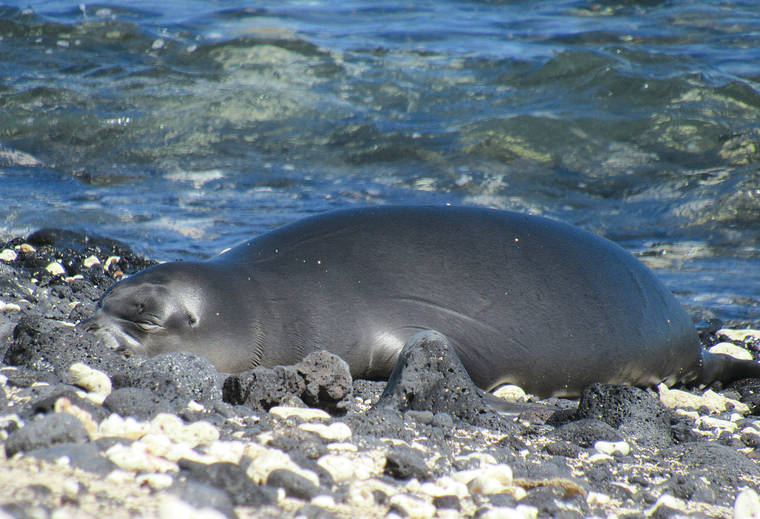Wildlife officials are asking the public to keep an eye out for — and a respectful distance from — monk seals this holiday weekend.
“We want everyone to have fun — we’re not trying to ruin anybody’s good time, but, if you’re going to be doing activities on the beach, it is so important to keep an eye out,” said Megan McGinnis, animal care manager for The Marine Mammal Center’s Ke Kai Ola Hawaiian Monk Seal Hospital in Kailua-Kona. “Just being overly aware of your surroundings is going to be a part of keeping these animals safe during this holiday weekend.”
In recent weeks, off-road vehicles have been driving in an area that has been cordoned off during daylight with signage posted overnight to protect Hiwahiwa, a male monk seal born in late April in the Mahaiula section of Kekaha Kai State Park. McGinnis and others, including the state Department of Natural Resources, are concerned about Hiwahiwa and other critically endangered monk seals being injured or killed.
“Unfortunately that is definitely a risk of driving close to the shore in an area where monk seals tend to hang out,” said McGinnis. “It is crazy easy to confuse (monk seals) with rocks. When there’s one that resting completely still; they look so much like lava rocks and they blend in so nicely.”
She noted that people have reported nearly stepping on a resting seal because they didn’t see the mammal while walking on the beach.
“You can get that close without ever realizing they’re there because they sleep really heavily. … It’s one of those things that makes them successful — blending into their surrounding,” McGinnis said. “But when it comes to people, it’s a little bit more of a curse.”
Hiwahiwa was born in late April to R405, a “transient” seal with a fairly unknown history first spotted in March 2019. He was weaned in mid-June, which is when R405 was last spotted by officials with the monk seal hospital.
“He’s so funny. He looks like a little watermelon right now, he’s not a very long seal but he’s definitely pretty beefy,” said McGinnis, noting Hiwahiwa is about 3 feet long.
The “weaner” is being kept busy by Kaulana, a male monk seal born last year at the same beach to RA20. Both Kaulana and RA 20 are doing well, as is Kaulana’s sister, Manuiwa, a female monk seal born in 2018 at Mahaiula.
“They’re all so shiny and beautiful,” McGinnis said, noting the three monk seals had recently finished molting.
Waimanu, another resident Big Island monk seal, is also doing well, though slightly overweight. McGinnis said Waimanu, born in 2008 at Waimanu Valley, is preparing to molt, as well.
“She’s starting to get a little green around the face too, though she probably won’t molt for a few months,” she said. “(The green) is usually kind of an indicator.”
An estimated 1,400 monk seals inhabit the main and Northwestern Hawaiian islands, according to NOAA. Approximately 300 of those seals cruise the waters and haul up on beaches in the main Hawaiian Islands, including about a half dozen on the Big Island.
The center advises that the public can play an important role in the conservation of the endangered species by keeping a few marine wildlife viewing tips in mind when visiting local beaches and wildlife preserves by keeping a safe distance from seals, using the zoom function on cameras and reporting sightings.
A good “rule of thumb” to know if you’re too close to a monk seal is to hold up your thumb perpendicular to the animal, and if you can see any of the seal, you are too close.
To report a sighting, call or text The Marine Mammal Center’s Hawaii Island response team at its 24-hour hotline at (808) 987-0765. To report wildlife harassment, call DLNR at (808) 643-DLNR or NOAA Fisheries’ Enforcement Hotline at (800) 853-1964.
“If someone sees someone doing something that makes them uncomfortable please report it to DLNR; those are the guys that can do something about it,” said McGinnis. “DLNR has an app and they have a line you can call. So even if you’re not quite sure and you just feel like something doesn’t look right, you can always take photos and videos that you can submit to DLNR. That’s really helpful too.”






